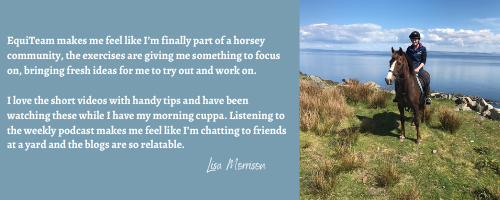Why do horses spook?
It’s that time of year again! All the memes come out about how just turning your horse out can become a dangerous sport. Riding in the dark, or not riding at all, starting to think we must all be mad…
I love my horse, I love my horse, I love my horse!
But what is it about winter that seems to turn our horse from unicorn to a fire breathing dragon?
Is it the cold weather?
Is it the wind?
Well to be honest there’s a whole bunch of reasons and depending on which type of spooky horse you have they will be differently affected and guess what…
That means the solution will be different for each horse.
Horses spook for four reasons:
- Pain
- Scared of ‘things’
- Tense and on adrenaline
- Distracted
For the horse that spooks because of pain or discomfort related problems, winter can bring the added stress of being isolated or confined for more of the day putting them more at risk for conditions like gastric ulcers on top of what they already have.
For the horse that’s scared of ‘things’ the wind can mean that the tree in the spooky corner is now even more terrifying because IT’S MOVING 😱
The tense and on adrenaline horse is not getting as much turnout so you get what I call ‘stored adrenaline’ so he’s already wired before you even get on.
And lastly with that added confinement our distracted horse has less to occupy his brain, so he’s already got too many ideas in his head to concentrate on you.
At this point, you could be forgiven for deciding that hamsters are a much more sensible choice of pet. But before you despair, let’s look at some solutions for these horses as once we know what the problem is, the solution is not that far away…
I’ll skip the horse in pain as the solution for this horse is to find and resolve the pain issues. Training will not heal a horse that is in pain, that’s like me telling you to go for a 10km run to heal a sprained ankle.
Horses that are Scared of ‘Things’ and Wind Sensitivity

Lots of horses are sensitive to the wind, why? Horses are prey animals, they don’t have horns like a cow or a goat so their primary means of staying safe is to run away from danger as fast as possible. This relies on them being able to spot that danger by being sensitive to movement or noise. When the wind is blowing, EVERYTHING is moving and it’s noisy! So they don’t know what they need to pay attention to and therefore they react to everything.
So what to do?
Desensitisation techniques, especially by using things that move or make a noise like flags or plastic bags are great to help a horse that is reactive in the wind, especially if you can build it up to teaching your horse to be more confident around sudden or unexpected motion. This will teach your horse to stay confident and connected to you in spite of everything going on around them.
Horses that are Tense and on Adrenaline
When a horse is tense or nervous, everything in their body is telling them they need to move. So being confined for more of the day can store up adrenaline for you when you are just wanting a nice quiet ride, making these horses more unpredictable. This is the horse that passes something 1, 2, 3, 4 times and on the 5th time – THEY’RE OFF! It’s not about the ‘thing’ it’s about the tension.
Doing groundwork before you ride can really help this horse use up some of that adrenaline so you don’t have to work it out from the saddle. If you’re a confident rider you can also do this from the saddle, I recommend using patterns that encourage the horse to bend through the ribs to really help this horse relax. Circles, figure 8’s, serpentines and lateral work can all really help this horse get more confident and connected.
Straight lines speed horses up and circles slow them down, the faster the horse, the smaller the circle you need.
Horse that are distracted
I like to call this one the ‘naughty spooker’ that’s because they usually don’t seem scared like the other types and this can lead us to find them more frustrating than the others! If you’ve ever said “My horse was looking for something to spook at!” You’ve probably got one of these.
These horses are often highly intelligent and need you to engage their brains and be more interesting. You can use groundwork for these guys too, try thinking up a fun task that gets them thinking. Don’t just lunge on a circle, pop in transitions and changes of rein. You can teach them something new, like go backwards through some poles or teach them to put their bridle on for example.

When you’re riding, you also need to engage their brains, pole work is great for these guys or obstacles like those in TREC or Working Equitation. If you haven’t got any of that, use changes of rein or transitions to keep your horse connected with you so their mind doesn’t wander to what’s behind the hedge!
I hope you find these tips helpful to make your winter a bit more bearable. I will be running the next part of my 4 part Spooky Horses Winter Masterclass Series on Monday at 6.30pm and I’d love you to join. Just drop me a DM with the word ‘WINTER’ and I’ll send you all the details.
Replays will be available too!
Happy riding.
Lyla
Read Lyla’s previous blog – Dealing with The Spooky Horses.
Find out more about Lyla and get access to her free training here: https://www.lylacansfield.com/online-learning
Contact Lyla here: https://www.facebook.com/@lylacansfield.equinetraining






